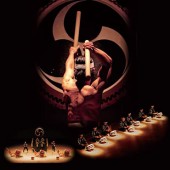Motofumi Yamaguchi: An Interview by Johnny Wales
Motofumi Yamaguchi: An Interview by Johnny Wales
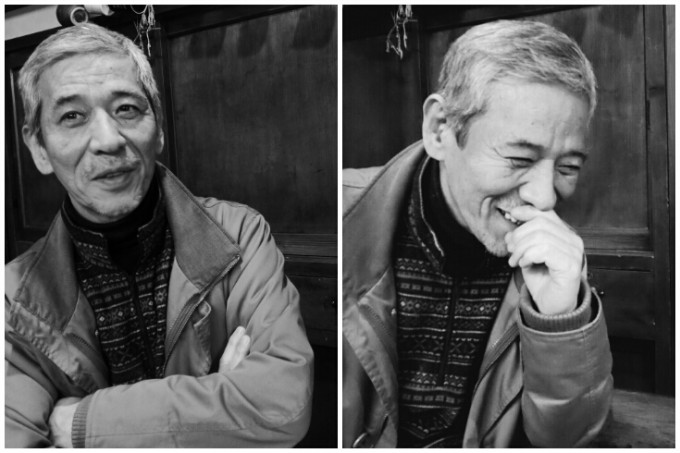
Motofumi, mid-interview (Photos: Johnny Wales)
Composer, arranger, fue (bamboo flute), koto (Japanese harp), shamisen (Japanese banjo-like stringed instrument), kokyu (Japanese violin), flute, cello and piano player Motofumi Yamaguchi was born in 1954 in Ibaraki Prefecture, just up the coast from Tokyo. His family moved to the big city when he was five years old. At high school and university (The Musashino Academy of Music) he studied Western classical music, composition, piano, cello and flute.
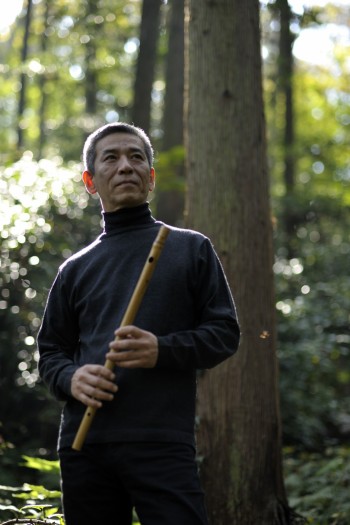
Photo: Takuro Susaki
In those days classical Japanese music was not generally held in very high regard among fellow students, and even some of the staff. It was seen as not quite as real as music from say, Germany or Italy. Motofumi began to feel this was very strange. Why shouldn’t Japanese have greater respect for their native culture? So he began seeking out performances of Noh and Kabuki, shamisen, koto and even Buddhist shomyo chanting. He was pleasantly surprised to discover that they felt very comfortable to him. He began to sense that he would be able to express himself more naturally in Japanese genres than Western. And so, at the age of 18, he began to study under shamisen (jiuta style) and koto teachers living nearby. He was surprised at how quickly he progressed and began to think that he had discovered a better, more natural direction for his career.
He was also beginning to tire of the big city and to dream of a life making music in the country. One day, while listening to his car radio, he heard vocalist and composer Ryudo Uzaki talking enthusiastically about his wonderful experience making music on Sado Island with a taiko group called Sado no Kuni Ondekoza. He talked about how amazing not only the taiko, but the koto and shamisen sounded too. Motofumi was fascinated and so went out and bought the two available Ondekoza records. They changed his life. As koto and shamisen were two of his instruments, he thought the group might have some use for him. He had heard about Ondekoza’s strict physical regimen and so decided to buy a bicycle. He would combine getting into shape with a 3-month holiday touring Japan. He quit his part-time job, drained his bank account and hit the road.
It was mid-November 1980 when he arrived unannounced at the group’s old wooden school house overlooking Mano Bay. After being reprimanded for not calling ahead, he was invited in and spent 3 days running at the crack of dawn, helping with cooking and cleaning and watching the group train. He returned to Tokyo with the understanding that he would move to Sado in January. Those were the days when there were no interviews, tests nor an apprentice system to join the group. If you showed up, demonstrated enough dedication and persistence, chances are you were in. Motofumi says with a chuckle that he (and quite a few other senior members) probably wouldn’t have gotten anywhere near the place under the current way of doing things!
This was just the time that Ondekoza was splitting off from the group’s founder Mr. Tagayasu Den, so things were in a great state of flux. Back in Tokyo, Motofumi met with Mr. Den and helped around the office for a week. Mr. Den suggested he learn the fue, and rather strangely, that he grow his beard. Motofumi followed his advice on the former matter and after arriving on Sado in the New Year he spent the next six months at the school house while the group toured, teaching himself the Japanese flute. It wasn’t long before he was touring with the group, something he carried on doing – including long stints as Musical Director – for the next 35 years.
After about 25 years performing for nine months of the year, Motofumi began to find life on the road more and more tiring. Because of this, for the last 10 years or so he has been slowly easing himself out of a featured role on the stage. He has also been gradually lessening his administrative duties so as to have more time to peruse his own, independent projects. The younger members have increasingly been taking over directorial responsibilities, too, so the timing seems right.
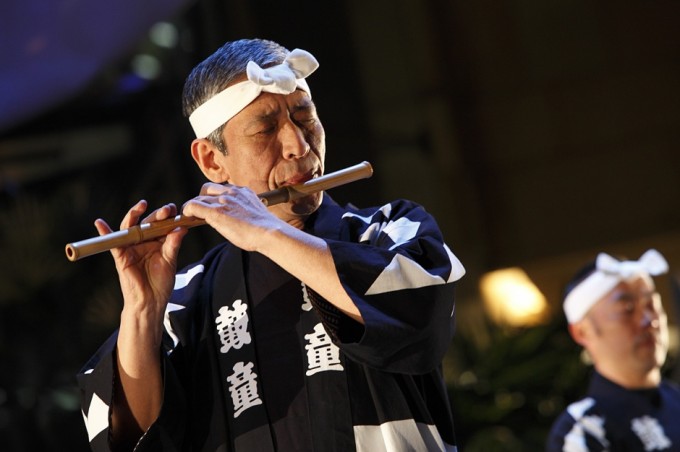
On stage with Kodo (Photo: Taro Nishita)
After being named one of Kodo’s four Distinguished Members just over two years ago, Motofumi recently turned 60. This age is not only a milestone in Japanese culture (being the completion of 5 cycles of the zodiac) it is also the age of compulsory retirement from Kodo’s administrative company Kitamaesen. So from now on – though he will continue to teach at the Apprentice Centre and appear in Kodo’s trademark headband and hanten coat – he will be doing so on a performance-by-performance contractual basis. His lessening duties with the group and life in a local community near Kodo Village have given Motofumi a chance to get to know the people, environment and culture of Sado unlike ever before. He is finally beginning to fulfill that dream he had so many years ago of making music while living life to the fullest in the country.
Five years ago Motofumi released his first solo record, “Ikkan Fugetsu,” on Kodo’s Otodaiku label. And now he is about to release his second work (still untitled), a blue-tinged collection of numbers that includes a piece dedicated to the memory of Akira Nino, the recently deceased jazz pianist who played on Motofumi’s first album. Appearing on the new CD together with Motofumi playing Japanese flute (shinobue and makobue) and cello, are Mikio Tsuji on his very rare 11-string classical guitar, with vocals by Yumi Nogami, and vocals and vertical koto by Yoshie Abe. This new CD helps mark a new beginning for Motofumi, in which he hopes to broaden his audience beyond fans of taiko and Kodo. He wants to be thought of not only as ‘Kodo’s Motofumi Yamaguchi’, but as ‘Motofumi Yamaguchi, the Fue Player’.
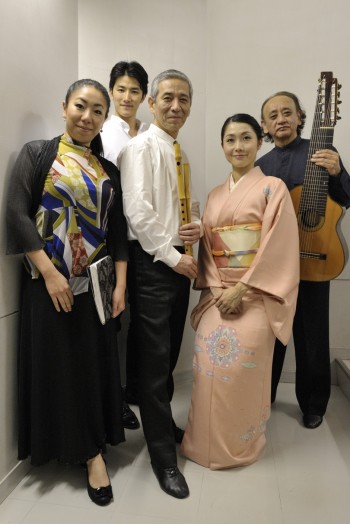
With the special guest artists for his recent “Ikkan Fugetsu” concert in Tokyo, Dec. 2014 (Photo: Takuro Susaki)
He has come full circle in his artistic life, beginning as he did as a student of Western music and then immersing himself in the world of Japan. Now the wall between the two has crumbled. He fuses them both into a world and sound of his own. Thanks to his long association with Kodo he has had the rare opportunity to work with an extraordinary range of some of the world’s finest musicians. Each and every one of them has had their influence on his musical palette.
Watch this space for the announcement of the release of Motofumi’s newest collaboration. In the hands of this remarkable musician, from a simple piece of bamboo drilled with holes, you may hear not only the sound of the sea of Sado Island, but echoes from every corner of the world.
Coming Up: Kodo 2015 Special Concert “Michi”
http://www.kodo.or.jp/news/20150319michi_en.html
Director: Motofumi Yamaguchi
Performers: Eiichi Saito, Tomohiro Mitome, Tomohiro Mitome, Mitsuru Ishizuka, Kenta Nakagome, Tsuyoshi Maeda, Rai Tateishi, others *Cast subject to change
Programme (TBC): Ameno Zoku, Jang-Gwara, Chonlima, Michi, Shamisen, Monochrome, Miyake, Sankan Shion, Yamauta, O-daiko, Yatai-bayashi
▶Watch on YouTube https://www.youtube.com/watch?v=r1N2ME9rH4E




